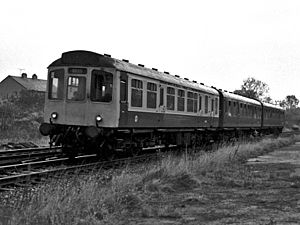British Rail Class 110 facts for kids
Quick facts for kids British Rail Class 110 |
|
|---|---|
 |
|
| In service | 1961- |
| Manufacturer | BRC&W |
| Formation | Two and three car |
| Operator(s) | British Rail |
| Specifications | |
| Car length | 57 ft 6 in (17.53 m) |
| Width | 9 ft 3 in (2.81 m) |
| Height | 3.88 m |
| Maximum speed | 70 mph (112 km/h) |
| Weight | 33.5 tonnes |
| Prime mover(s) | Rolls-Royce, 180 bhp |
The Class 110 trains were a special kind of train called a Diesel Multiple Unit, or DMU. This means each train car has its own engine, so it doesn't need a separate locomotive to pull it along. These trains were built in 1961 and were designed to carry passengers across parts of northern England.
Contents
What Are Class 110 Trains?
The Class 110 DMUs were built by a company called the Birmingham Railway Carriage and Wagon Company, working with the Drewry Car Co.. They were made specifically to run on the main railway lines that used to belong to the Lancashire and Yorkshire Railway. These trains spent their entire working lives in the same area. Because of this, they earned a special nickname: the Calder Valley sets. The Calder Valley is a beautiful area in West Yorkshire, England, known for its river and hills.
How Were They Designed?
The Class 110 trains were an improved version of an earlier train model, the British Rail Class 104. The engineers made some cool updates to the design.
- They changed the front part of the train, called the cab, where the driver sits. This gave the Class 110 a fresh, new look.
- They also raised the frames around the windows on the side of the train. This small change made the trains look a bit different and perhaps offered better views for passengers.
What Made Them Go?
Each car of a Class 110 train had a powerful Rolls-Royce engine. These engines provided 180 horsepower, which was enough to get the trains moving at a good speed. The Class 110 trains could reach a top speed of 70 miles per hour (about 112 kilometers per hour). This made them quite fast for their time, helping people travel quickly between towns and cities in the Calder Valley region.
Where Did Class 110 Trains Operate?
These trains were a common sight in the Calder Valley area of northern England. They ran on important routes, connecting towns and cities like Manchester, Bradford, Leeds, and Halifax. They were a vital part of the local transport system, helping people get to work, school, or visit friends and family. Their long service in this specific region made them very well-known and loved by the local communities.

